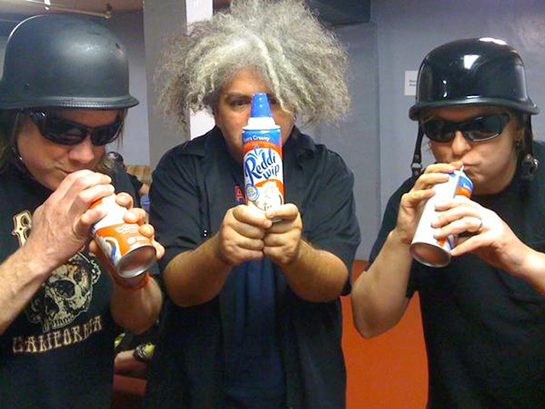Today Adam introduces us to the awesome (and decidedly metal) Alice…
Alice in Chains is an American rock band that emerged from Seattle, Washington, in the early 1990s. They were often lumped in with the grunge movement because they came around at the same time as other grunge acts and their music shared some elements with grunge, but their heavy guitar sound and high level of musicianship had more in common with metal bands than anything else. If Alice in Chains was not recognized as metal, it was more a result of the timing of their emergence than anything else. Regardless of their label, Alice in Chains was one of the most prominent rock bands of the ’90s and their music was an influence for many bands to come.
 One of the things that was most notable about Alice in Chains were the gloomy, dark sounding vocals of lead singer Layne Staley. Staley and guitarist Jerry Cantrell would often harmonize vocals together to produce a pitch that was highly innovative at the time. Since then, many bands have gone on to imitate this style of singing, but Alice in Chains were the first to embrace it. Another aspect of the band that brought them to the spotlight was Jerry Cantrell’s guitar work. Cantrell was known for his smooth style of playing as well as his impressive soloing skills, which is something that separated the band from typical grunge bands, who would rarely have guitar solos in their songs. The other two members of the band are Sean Kinney on drums and Mike Inez on bass. Prior to Mike Inez joining the band, Mike Starr was the bassist.
One of the things that was most notable about Alice in Chains were the gloomy, dark sounding vocals of lead singer Layne Staley. Staley and guitarist Jerry Cantrell would often harmonize vocals together to produce a pitch that was highly innovative at the time. Since then, many bands have gone on to imitate this style of singing, but Alice in Chains were the first to embrace it. Another aspect of the band that brought them to the spotlight was Jerry Cantrell’s guitar work. Cantrell was known for his smooth style of playing as well as his impressive soloing skills, which is something that separated the band from typical grunge bands, who would rarely have guitar solos in their songs. The other two members of the band are Sean Kinney on drums and Mike Inez on bass. Prior to Mike Inez joining the band, Mike Starr was the bassist.
The band’s first album was entitled Facelift. This album has one of Alice in Chains’ most well known songs, “Man in the Box”:
The band immediately got recognition for their unique sound with the release of their first album. The band’s third album, entitled Dirt, was a great album and is considered by many to be the band’s most prominent album. The songs on the album reflect in large part lead singer Layne Staley’s lengthy battle with substance abuse and addiction. Songs like “Junkhead” and “Hate to Feel” clearly portray Staley’s desperate state of mind as he fought against his addiction to drugs, primarily heroin. The band in fact had to cancel two of their biggest tours because Staley was in such bad condition as a result of his drug abuse.
The band put out a live album that debuted on MTV Unplugged. It was the band’s first live performance in three years. When guitarist Jerry Cantrell released a solo album entitled Boggy Depot, which was pretty much Alice in Chains without Layne Staley, it became clear that the band had been derailed by the lead singer’s problems. In April 2002, on the same date that grunge icon Kurt Cobain committed suicide with a self-inflicted gunshot wound, Alice in Chains lead singer Layne Staley was found dead in his Seattle home. His body wasn’t discovered until three weeks after his passing. The official cause of death was a fatal injected dose of heroin mixed with cocaine, also known as a speedball.




 Once the movement hit America, it started undergoing changes. It began with a more pop-friendly commercial sound, which became known as glam metal. This genre was responsible for bands like Ratt (pictured at right), Poison (below left), and Mötley Crüe (below right). One of the common themes of this genre is the way the bands would dress. The members would wear feminine clothing and makeup; this is what started the name glam metal or glam rock. This look, mixed with the poppy lyrics about love and relationships, created a highly mainstream sensation. The music consisted of simple time structures with high pitched vocals. The guitars would sometimes offer good riffs and technical solos, but for the most part the appeal of the genre was lost on the metal fan base, who wanted something heavier.
Once the movement hit America, it started undergoing changes. It began with a more pop-friendly commercial sound, which became known as glam metal. This genre was responsible for bands like Ratt (pictured at right), Poison (below left), and Mötley Crüe (below right). One of the common themes of this genre is the way the bands would dress. The members would wear feminine clothing and makeup; this is what started the name glam metal or glam rock. This look, mixed with the poppy lyrics about love and relationships, created a highly mainstream sensation. The music consisted of simple time structures with high pitched vocals. The guitars would sometimes offer good riffs and technical solos, but for the most part the appeal of the genre was lost on the metal fan base, who wanted something heavier.